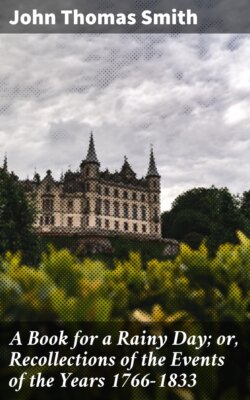Читать книгу A Book for a Rainy Day; or, Recollections of the Events of the Years 1766-1833 - John Thomas Smith - Страница 27
На сайте Литреса книга снята с продажи.
1786.
ОглавлениеTable of Contents
Possibly the present frequenters of print sales may receive some little entertainment from a description of a few of the most singular of those who constantly attended the auctions during my boyish days. The elder Langford, of Covent Garden, introduced by Foote as Mr. Puff, in his farce of The Minor,[195] I well remember; yet by reason of my being obliged to attend more regularly the subsequent evening sales at Paterson’s and Hutchins’s—next-door-neighbour auctioneers, on the north side of King Street, Covent Garden,[196] I am better enabled to speak to the peculiarities of their visitors than those of Mr. Langford.
It was in 1783, during the sales of the extensive collection of Mr. Moser, the first keeper of the Royal Academy,[197] and Mr. Millan, bookseller at Charing Cross,[198] that I noticed the following remarkable characters. I shall, however, first endeavour to describe the person of Paterson, a man much respected by all who really knew him; but perhaps by none with more sincerity than Doctor Johnson, who had honoured him by standing godfather to his son Samuel, and whom he continued to notice as he grew up with the most affectionate regard, as appears in the letters which the doctor wrote in his favour to his friends Sir Joshua Reynolds and Mr. Humphrey, printed by Boswell.[199] Mr. Paterson was in height about five feet eight inches, and stooped a little in the shoulders. When I first knew him, he was a spare man, and wore a powdered clubwig, similar to that worn by Tom Davies, the bookseller and biographer of Garrick, of whom there is an engraved portrait. Paterson was really a walking library, and of manners precisely coinciding with the old school. I remember that by a slight impediment in his speech, he always pronounced the letter R as a V; for instance, Dart’s History of Canterbevy, and a dromedary, he pronounced a dwammedavy; notwithstanding this defect, he publicly lectured on the beauties of Shakspeare.
Mr. Gough,[200] the Editor of Camden’s Britannia, was the constant frequenter of his book-sales. This antiquary was about the same height as the auctioneer, but in a wig very different, as he wore, when I knew him, a short shining curled one. His coat was of “formal cut,” but he had no round belly; and his waistcoat and smallclothes were from the same piece. He was mostly in boots, and carried a swish-whip when he walked. His temper I know was not good, and he seldom forgave those persons who dared to bid stoutly against him for a lot at an auction: his eyes, which were small and of the winky-pinky sort, fully announced the fretful being. As for his judgment in works of art, if he had any it availed him little, being as much satisfied with the dry and monotonous manner of Old Basire,[201] as our late President West was with the beautiful style of Woollett and Hall.
Dr. Lort,[202] the constant correspondent of Old Cole,[203] was a man of his own stamp, broad and bony, in height nearly six feet, of manners equally morose, and in every respect just as forbidding. His wig was a large Busby, and usually of a brown appearance, for want of a dust of powder. He was chaplain to the Duke of Devonshire; and as he wore thick worsted stockings, and walked anyhow through the mud, considered himself in no way obliged to give the street-sweepers a farthing. He had some wit, however, but it was often displayed in a cowardly manner, being mostly directed towards his little opponent, Doctor Gossett,[204] who was unfortunately much afflicted by deformity, and of a temper easily roused by too frequent a repetition of threepenny biddings at Paterson’s. Paterson sold his books singly, and took threepence at a bidding.
Hutchins was about five feet nine inches, but in appearance much shorter by reason of his corpulency. His high forehead, when compared with a perpendicular, was at an angle of forty-five. He was what Spurzheim would call a simple honest man: his wife was of the same build, but most powerfully possessed the organ of inquisitiveness, which induced her to be a constant occupant of a pretty large and easy chair, by the side of the fire in the auction-room, in order that she might see how business was going on. Mr. and Mrs. Hutchins appeared so affectionately mutual in all their public conclusions, that Caleb Whitefoord, the witty wine-merchant, one of the print-sale visitors, attempted to flourish off the following observation as one of his invention: “You see,” said he to Captain Baillie, “Cocker is not always correct; one and one do not in this instance make two.”[205]
Caleb Whitefoord[206] was what is usually called a slight-built man, and much addicted when in conversation to shrug up his shoulders. He had a thin face, with little eyes; his deportment was gentlemanly, though perhaps sometimes too high for his situation in life. His dress, upon which he bestowed great attention, was in some instances singular, particularly in his hat and wig, which were remarkable as being solitary specimens of the Garrick School. He considered himself a first-rate judge of pictures, always preferring those by the old masters, but which he endeavoured to improve by touching up; and when in this conceited employment, I have frequently seen him fall back in his chair, and turn his head from one shoulder to the other, with as much admiration of what he had done, as Hogarth’s sign-painter of the Barley-mow in his inimitable print of Beer Street.
